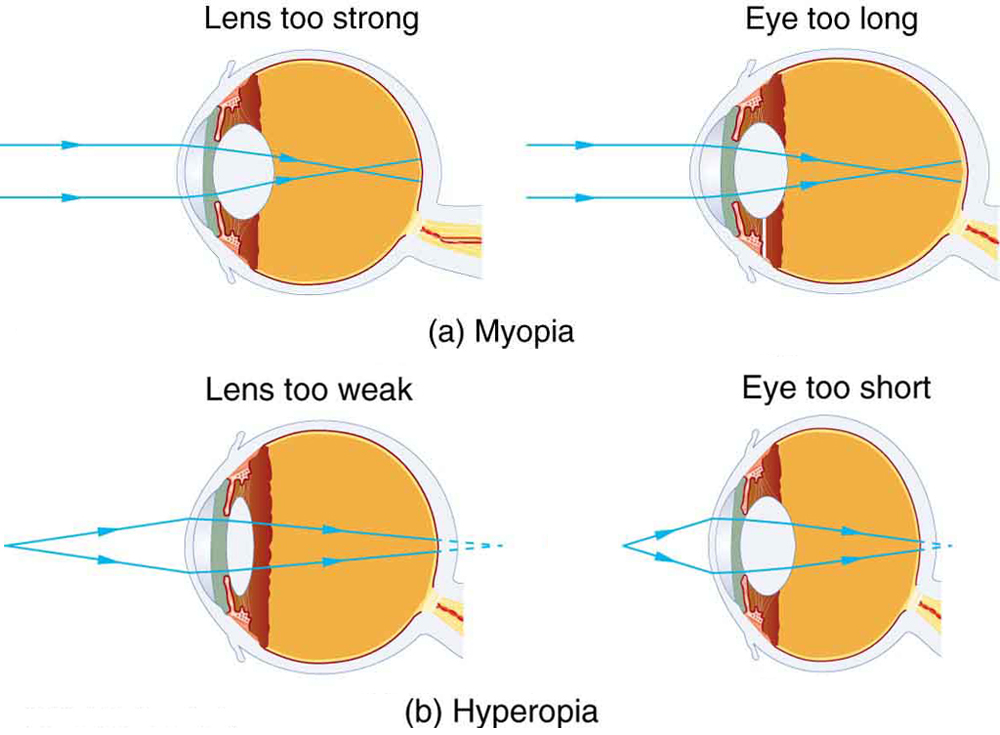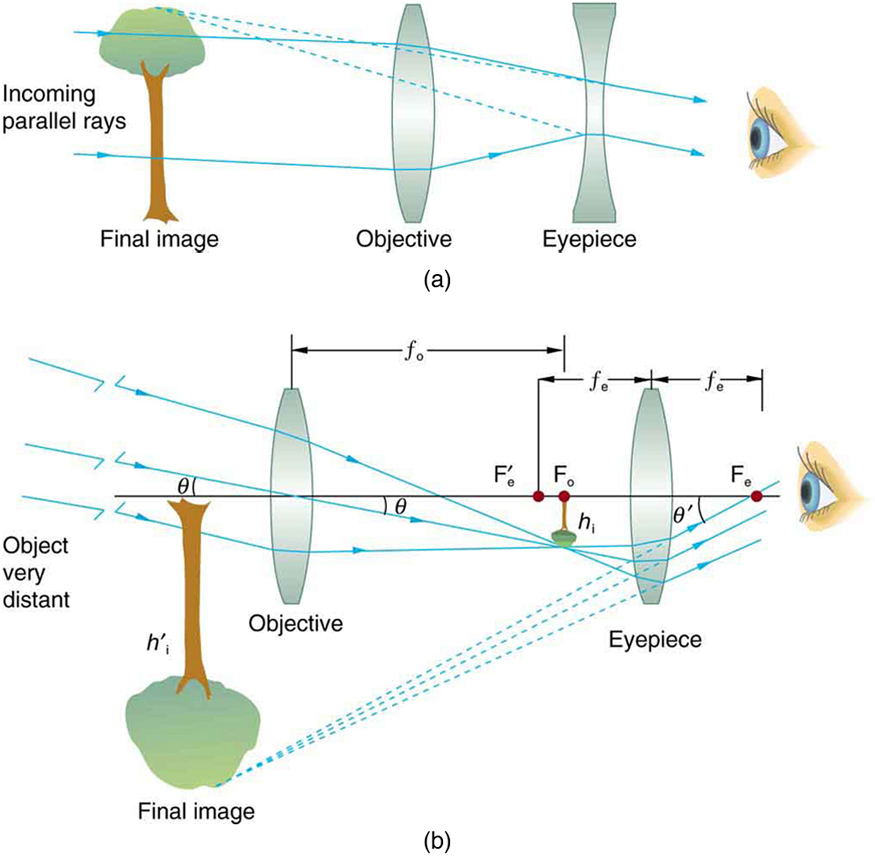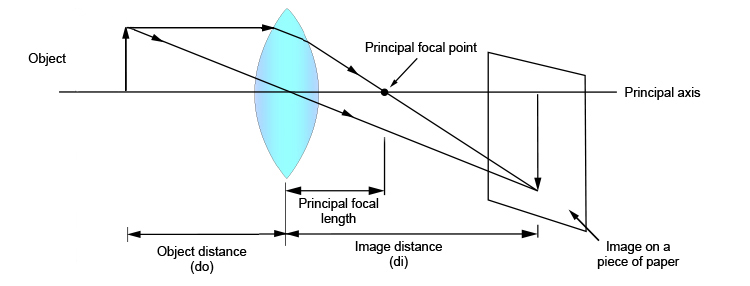Which Lens Is Used to See Distant Object
Hence option A is correct. Lenses used to correct nearsightedness are concave in shape.
231 which shows an object AB.

. Iii Bifocal lens will be required to see clearly nearby as well as the distant object. Nearsightedness the condition where a person can see near objects clearly but distant objects are blurry typically is easily corrected with prescription eyeglasses or contact lenses. In such conditions it is advised to use bifocal lenses.
A lens is a transmissive optical device which focuses or disperses a light beam by means of refraction. Can see distant objects clearly. Take a picture of the moon with a 35mm or 50mm lens and it will appear as a very small dot in the final image.
NoteLenses having negative power will extend the focus of a myopic person and give them a good vision. A thin convex lens whose focal length in air is known to be 30 cm is cut into two parts by a transverse plane parallel to the principle axis and 05 cm above the principle axis. We can see some people who suffer from myopia as well as hypermetropia disorders.
In practice such a lens is held close to eye and the distance of the object is adjusted till a clear image is formed at the least distance of distinct vision. A double convex lens or converging lens focuses the diverging or blurred light rays from a distant object by refracting bending the rays twice. Placing concave lenses in front of a nearsighted eye decreases the light refraction and the focal length is increased.
Usually bi-focal lenses consist of concave as well as convex lenses. That means the spectacle lens must produce an image 300 cm from the eye for an object very far away. 1focal-length 1distance-in-front 1distance-in back of the lens or optical system So if an object is at infinity then 1infinity 0 so.
A person cannot see the objects clearly placed at distance more than 4 0 c m. It is caused due to either Low converging or focusing power of crystalline eye-lens or it could be due to eye-ball being too short. The image distance is negative because it.
It consists of a convex lens that is soft and pliable. Can see nearby objects distinctly. A simple lens consists of a single piece of transparent material while a compound lens consists of several simple lenses usually arranged along a common axis.
In eyeglasses that correct nearsightedness concave lenses are used. This double bending causes the rays to converge at a focal point behind the lens so that a. It is attached to the lens by zonules ligament fibres that can be tight or loose.
Therefore we must get d i 285 cm when d o. Cannot see nearby as well as distant objects. It is used to make distant objects appear magnified with magnification increasing as longer focal length lenses are used.
This ciliary muscle can change the shape of the crystalline lens by stretching it at the edges. A man cannot see clearly the objects beyond a distance of 20 cm from his eyes. The higher the power of the lens the more far point can be.
For myopic defect upper part of bifocal lens consists of a concave lens used for distant vision and to correct hypermetropia lower part of bifocal lens consists of a convex lens. The light from the object first enters the objective lens which will produce a real image I 1. So if you have old reading glasses you can use them for.
A person with hypermetropia can see distant objects clearly but cannot see nearby objects distinctly. The ciliary muscle is a circular ring of muscle that attaches all the way around the lens. Such powers can be found in older reading glasses if the person has been using and changing glasses in the past.
A concave lens is used for a myopic eye to decrease the converging power of the eye lens. This combination is equivalent to the type of mirror and its focal length is. The bi-focal lens has the upper portion concave lens and a lower portion with the convex lens to facilitate distant vision and near vision.
It facilitates near vision. The power of the lens required to see far objects will be MP PMT 1993 2003. In hypermetropia human eye _____.
A long-sighted person cannot see objects clearly at a distance less than 4 0 c m from his eye. The power of the. He is advised to use lens of power.
A man can see the objects upto a distance of one metre from his eyes. This image then acts as the object for the second lens the eyepiece. To see distant objects clearly the kind of lenses and its focal length must be Q.
An image 300 cm from the eye will be 285 cm to the left of the spectacle lens see Figure 2. The nearsighted eye overconverges the nearly parallel rays from a distant object and the rays cross in front of the retina. Of course any lens can see distant objects it only matters if you want the final distant object image to be very large in the final photo.
The plane face of plano-convex lens of focal length 20 cmis silvered. Going back to the above example a person of 50 years of age would see near objects clearly with 150 Diopter glasses and would see objects at intermediate distance clearly with 050 or 075 Diopter glasses. For correcting his eye sight so that he can see an object at infinity he requires a lens whose power is or A man can see upto 100 cm of the distant object.
Answer 1 of 5. Use a 1200mm or more and you will like the big image of the moon a lot better. More divergent rays from a close object are converged on the retina producing a clear image.
Choose the correct option. In photography a long-focus lens is a camera lens which has a focal length that is longer than the diagonal measure of the film or sensor that receives its image. A long-focus lens is one of three basic photographic lens types classified by relative focal length the.
These lenses are called minus power lenses or minus. We know that when an object is placed between the optical center and the focus of a convex lens its image is virtual erect and magnified and on the same side as the object. If distant means distant then no information beyond far away The basic equation is.
You want this nearsighted person to be able to see very distant objects clearly. In other words they are thinnest at the center and thicker at the edge. Hypermetropia Long-sightedness or Far-sightedness.
Due to elongation of _____ and increase in curvature of the eye lens a person cannot see distant objects clearly. Nearsightedness or myopia is the inability to see distant objects clearly while close objects are in focus. This is illustrated in Fig.
Lenses are made from materials such as glass or plastic and are ground and polished or molded to a desired. In a refracting telescope two convex lenses are used to generate an enlarged image of a distant object see the figure below.

Vintage Binocular By Divyanshu Garg3ds Max Model Madel In 3dsmax Binoculars Optical Device Used With Both Eyes Simultaneo Vintage Binoculars Binoculars Vintage

Parameters Listed On The Prism Cover Plate Describing 7 Power Magnification Binoculars With A 50 Mm Objective Diameter And A 372 Binoculars Magnification Power

Pin By Sanghita Dey On Cbse Class 10 Sample Paper Human Eye Bullet Journal

Best Binoculars For Kids Exciting Outdoor Adventures 2020 Outdoor Hunting Binoculars For Kids Binoculars

Why Do Binoculars Have Red Lenses Lens Binoculars Optical Lens

Vision 2020 E Resource Optician Training Eye Facts Eye Health

Binoculars Optical Instrument Set Glass Lenses For Viewing Distant Objects To Make A Vintage Business Cards Template Binoculars Social Media Design Graphics

Jupiter 21m 200mm F4 Russian Vintage Lens For Nikon 1 Etsy Vintage Lenses Vintage Canon Lens

Baker S Vivitar 500mm 1000mm F 8 Telephoto Lens For Canon 70d 77d And 80d 1 Telephoto Zoom Lens Nikon Dslr Camera Canon Digital Slr Camera

Why A Photographer Needs A Teleconverter Photographer Needed Focal Length Photographer

Where Is The Limit How Far You Can See With Binoculars Canning Binoculars Distant

26 2 Vision Correction College Physics Openstax






Comments
Post a Comment